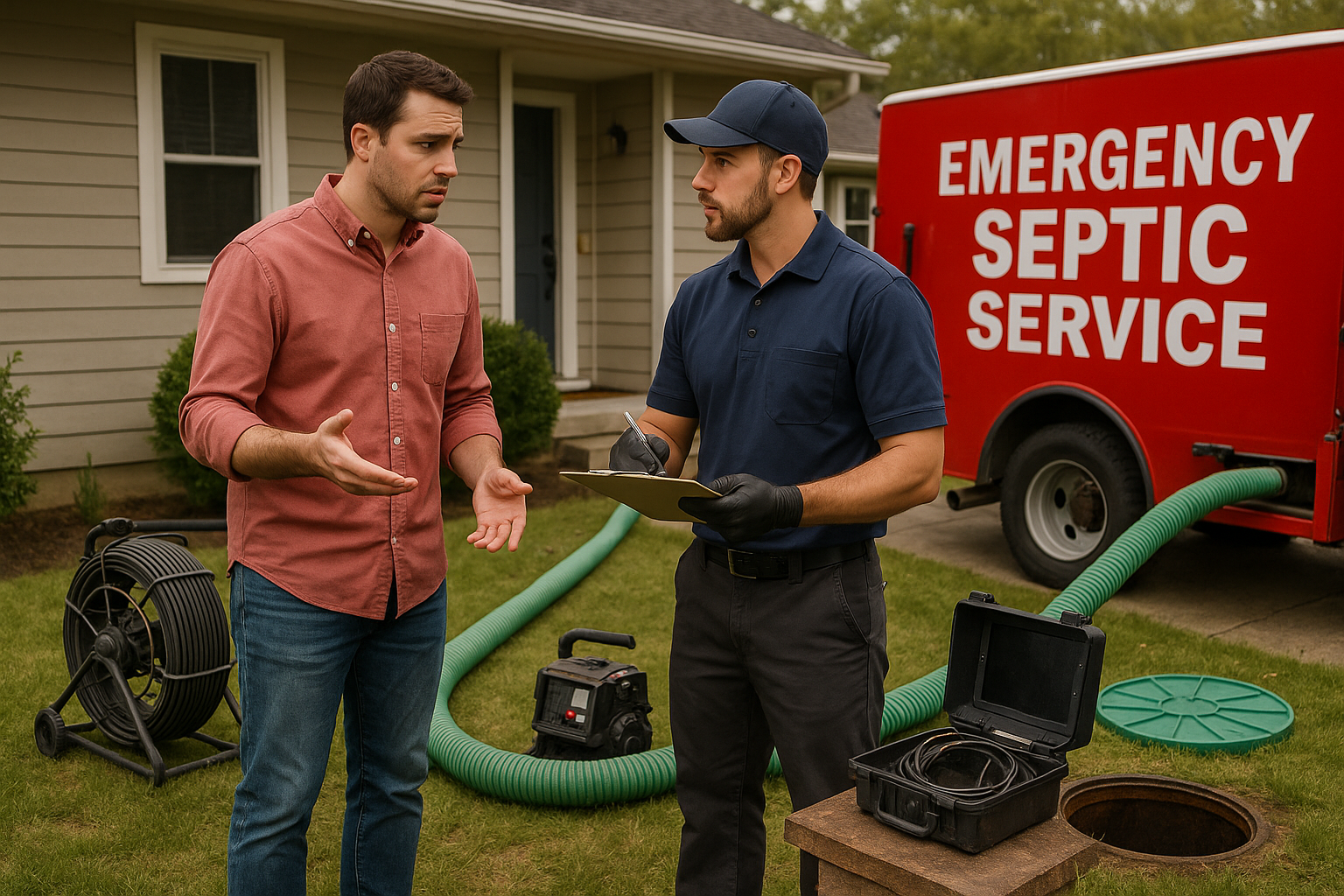When your septic system fails without warning, it can cause instant panic. One minute, everything seems fine; the next, you’re dealing with foul odors, overflowing drains, or standing wastewater in your yard. Situations like these require emergency septic tank emptying—a fast, professional service designed to prevent further damage and protect your home’s sanitation and safety.
Most homeowners don’t think about their septic systems until something goes wrong. But when a tank overflows or clogs, immediate action is non-negotiable. Delaying service, even by a few hours, can result in contaminated water backing up into sinks, tubs, and floors. This can damage property, create unbearable smells, and expose your family to harmful bacteria.
Having a trusted septic service on call ensures that help is just one phone call away. Experienced technicians use high-powered vacuum trucks and precision diagnostic tools to quickly extract waste, inspect your system, and restore functionality. Whether you live in a rural community or a suburban area, septic issues can strike unexpectedly—often after heavy rainfall, excessive water usage, or neglected maintenance.
Understanding what causes septic emergencies, recognizing early signs, and knowing how to respond will help you take control of the situation. This guide breaks down everything you need to know—from identifying early warning signs to learning how to prevent future issues and choosing reliable professionals.
Recognizing the Signs of a Septic Emergency
Many homeowners mistake early warning signs for minor plumbing issues—until it’s too late. A septic emergency typically begins with subtle hints that worsen quickly if ignored. Recognizing these signals early can save you from extensive property damage and expensive repairs.
Here are the most common red flags that suggest your septic tank is full, blocked, or failing:
- Strong sewage odors near drains, toilets, or around your yard
- Slow drains or gurgling noises coming from sinks, tubs, or toilets
- Unexpected water backups in low-level fixtures, especially basements or ground floors
- Puddles or soggy areas forming above your drain field or near the tank lid
- Extra-lush grass patches or abnormally green areas over the septic system
While some issues may result from a simple clogged septic line or overuse of water, others can stem from deeper system damage. If waste levels are rising faster than expected or solid buildup is obstructing flow, your septic tank may reach critical capacity.
Professional septic experts can use advanced tools like inspection cameras or hydro-jetting systems to pinpoint the problem without unnecessary digging. Early intervention keeps wastewater from seeping into your yard or home and helps maintain proper system pressure. Remember—when foul smells or slow drainage appear, that’s your system’s way of saying it needs urgent attention. Don’t ignore the signs; call for emergency septic tank emptying right away.
Fast Response: What Happens During Emergency Septic Emptying
When you call a 24-hour septic service, their response is designed to be quick, safe, and thorough. Reliable companies understand that emergencies can’t wait until morning. They arrive promptly—often within the hour—fully equipped to handle even the most critical situations.
Here’s a step-by-step breakdown of what happens during emergency septic tank emptying:
- Initial inspection: The technician begins by assessing your tank, drain field, and connecting pipes to identify where the issue lies.
- Vacuum pumping: High-capacity vacuum trucks extract the sludge, scum, and wastewater that cause overflow and pressure buildup.
- Line clearing: If blockages are detected, hydro jetting or mechanical rodding clears debris, grease, and buildup.
- System check: Components like filters, baffles, and inlet/outlet tees are inspected for cracks, corrosion, or misalignment.
- Disinfection and cleanup: The area around the septic tank and yard is cleaned and disinfected to ensure no contamination remains.
To understand this process in greater detail, you can review septic tank emptying explained for a more technical overview.
The goal of an emergency pump-out isn’t just to remove waste—it’s to restore the septic system’s functionality safely and efficiently. Experienced technicians will also document the visit, providing you with insights into what caused the emergency and what preventive steps you can take moving forward.
Fast action saves you from extensive cleanup, unpleasant odors, and costly reconstruction work. In many cases, same-day service prevents raw sewage from reaching your home interior, protecting both your property and your peace of mind.
Preventing Future Septic Emergencies
Once you’ve gone through a septic emergency, prevention becomes a top priority. Fortunately, most septic disasters are entirely avoidable through proper maintenance and care. Keeping a close eye on your system’s performance and scheduling regular servicing are the simplest ways to avoid future breakdowns.
Here are several proactive steps to keep your system running smoothly:
- Pump your septic tank regularly every 3–5 years, depending on household size and water use. To stay organized, check creating a septic emptying schedule for your home for helpful guidance.
- Avoid flushing non-biodegradable materials like paper towels, wipes, diapers, or sanitary products—they can clog lines and cause overflows.
- Be cautious with chemicals: Avoid pouring bleach, paint, or harsh drain cleaners down the drain, as they kill essential bacteria that break down waste.
- Manage water flow: Fix leaks immediately and spread out laundry loads to reduce pressure on the system.
- Protect the drain field: Keep vehicles and heavy equipment off your septic area to prevent soil compaction or pipe damage.
- Redirect rainwater: Ensure that gutters and downspouts don’t flood your drain field.
For those who prefer to take a hands-on approach, this guide on DIY septic system maintenance offers simple ways to care for your system safely.
Routine maintenance not only prevents emergencies but also saves thousands in potential repair costs. A septic system that’s regularly inspected and pumped lasts significantly longer, runs more efficiently, and maintains a cleaner, healthier environment for your household. Remember: a little prevention today saves you from a messy crisis tomorrow.
Finding Reliable Emergency Septic Services Near You
In a true emergency, having a trusted provider makes all the difference. You don’t want to waste precious time searching online or comparing reviews while sewage backs up into your home. Establishing a relationship with a reliable local septic service ensures that help is ready when you need it most.
When choosing a provider for emergency septic tank emptying, keep these factors in mind:
- 24/7 availability: Choose a company that provides around-the-clock support. Septic problems don’t wait for business hours.
- Transparent pricing: Ask for upfront quotes. To better understand current market rates, check septic tank emptying costs in 2025.
- Licensed and certified technicians: Ensure that your provider meets local regulations and industry standards for safety.
- Comprehensive service options: The best companies handle everything—from inspection and pumping to repair and maintenance.
- Local experience and strong reputation: Look for long-standing service providers with proven track records in your community.
A reliable company won’t just perform an emergency cleanup—they’ll identify the underlying issue and recommend preventive solutions. Many also provide maintenance plans to keep your septic system in excellent condition year-round.
Local providers have another advantage: they understand regional soil types, regulations, and seasonal challenges that may affect your system’s performance. Building a relationship with them means faster service and personalized care when emergencies strike.
Keep their contact information handy—you’ll be glad you did when you need immediate, professional help.
The Importance of Proactive Care
The key takeaway for any homeowner is this: prevention and awareness are your strongest defenses. By knowing how your septic system works, you can spot irregularities early and respond before they spiral into emergencies.
Many homeowners find it helpful to schedule annual inspections, even if pumping isn’t required. Technicians can assess sludge buildup, inspect drain fields, and check for minor leaks before they turn into major failures. For consistent care, follow your septic company’s recommended maintenance timeline and keep service records in a dedicated folder.
And don’t forget the importance of community knowledge—sharing tips and local service recommendations with neighbors can help everyone stay prepared. Whether you’re a new homeowner or have relied on your system for decades, staying informed will always be your best tool for avoiding trouble.






